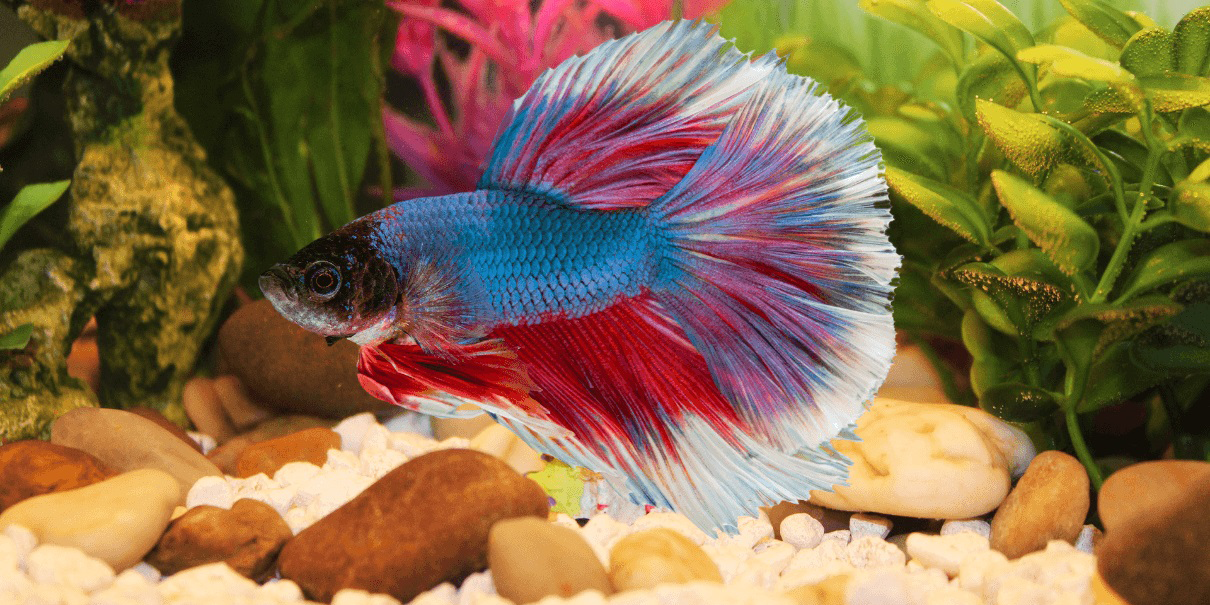
Siamese Fighting Fish as Pets
Fish
General Advice
05/05/2023
The hardy Siamese Fighting Fish is easy to keep, quite placid on its own, and ideal for first-time or busy pet owners - so don’t be put off by the intimidating name.
Siamese Fighting Fish are some of the most beautiful of aquatic fish, with their brilliant colours and long, flowing fins. They are also exceptionally tolerant of varying water conditions, making them one of the most popular of wet-pets especially with first time fish keepers.
Usually referred to by the genus name betta, these fish can be found in the wild throughout the Mekong Delta region of Southeast Asia, where they breed in warm shallow water. Bettas have evolved a special respiratory organ that allows them to gulp air from the surface. This lets them survive in very small areas of oxygen-poor or stagnant water, such as rice paddies, roadside drains and even a water-buffalo hoof print.
Siamese fighting fish are aggressive
Bettas got their common name from the aggressiveness of the males who have evolved to protect their naturally small territories. The male also makes the nest and protects the eggs. Two males in the same tank will attack each other until one gives up fighting. In the wild, the defeated male has a chance of escape, but in an aquarium it will be attacked incessantly. For this reason, you can only have one male betta in a single aquarium. Females usually get along together, depending on their temperaments, but putting a female permanently in with a male is not recommended. When confronting each other, male bettas put on a vivid display of colour and flared fins, which can be encouraged by putting a mirror inside the aquarium.
The males only fight with their own species and are quite placid with other community aquarium fish such as swordfish, platys or mollies. In fact, they are so good-natured with other fish species, you can’t put them in with larger or aggressive fish, as they will be beaten up.
Housing your siamese fighting fish
Overseas, bettas are sold in smallish bowls (even vases), however, unless you want to be cleaning out the water every day, this is not healthy for the fish. Bettas need warm, clean water and room to exercise their fins to maintain good appearance. Aquatic specialists in New Zealand recommend a tank of at least 35 litres with filtration and heating systems (the water needs to be between 24-27°C). The tank needs to be large enough to allow plenty of space for your Betta to move and explore, which is necessary to keep him healthy. The floor of the tank should have a thin (5mm) layer of gravel to encourage nitrifying bacteria that will help keep the water clean, and you can decorate your tank with live or silk plants to provide some hiding places for your pet. Just make sure any decorations are free of rough or sharp points that could damage your bettas delicate fins. Also be sure that your tank or aquarium has a lid, as betta are known to jump out of their tanks if given the chance! Although bettas can live in very poor-quality water, these fish are prone to diseases such as fin rot, picked up in dirty conditions, so their aquarium needs to be cleaned every few weeks and the water changed regularly.
What to feed your Siamese fighter fish
In the wild, the fighter fish survives almost solely by eating insects and their larvae. These fish have a much shorter digestive system meaning they do very well eating meat and live feed. The best thing to feed your betta is high protein live or frozen products such as brine shrimp, daphnia, tubifex worms, glass-worms or beef heart. Although they can also do well on a mixed diet consisting of betta pellets or flakes, freeze dried insects and live food. But it is important to be careful not to feed your Betta too much, as any leftover food in the tank will break down and rot and this can lead to a higher likelihood of your fish developing a disease related to dirty water. As a rule of thumb you should only feed your fish as much food as they can eat within two minutes and if there is any left over cut down the feed size next time.
Siamese fighting fish are very attractive
You can buy bettas in a variety of different tail colours and shapes – from veil-tails, crown-tails to delta-tails and the much sought-after 180° half-moon tail. Although in their wild form these fish are a lot less colourful coming in shades of brown and grey. But due to captive breeding programs they are available for sale in a wide variety of colours, including white, yellow, orange, red, pink, blue, green, turquoise, brown, and black. A wide range of patterns and colour combinations can be seen, from solid colours to those with different fin and body colours, to patterned colours. However, the variety of fish in New Zealand is far more limited than it is overseas where breeding has reached an art form. Growing to about 7.5cm in length, the males have showier fins and more colour than females, which are about half the size.
Cost of Siamese fighting fish
A common veil-tail male betta will cost around $18 - $22 at your local pet shop or aquatic specialist. The more exotic-tailed fish cost more; for example a crown-tail betta will likely cost around $34.
In good health, your fish can live up to two years, but remember it will already be around six months old, or middle-aged when you buy it.
A suitable aquarium of 35 litres with filtration system, heater and aquatic decoration will cost close to $100.
House Dad
It is the betta male that looks after the kids. He makes a bubble nest anchored to a floating item on the water surface, such as an aquatic plant. After enticing the female to the surface, he wraps himself around her and squeezes out the eggs. After quickly fertilising the eggs, he collects them in his mouth and spits them out onto the bubble nest, then aggressively guards them, catching any fallen eggs and spitting them back onto the nest until they hatch, up to 36 hours later.

Written by The Pet.co.nz
Team
Written by The Pet.co.nz Team
A team of specialists with backgrounds in animal nursing, animal care, and all things pet related.